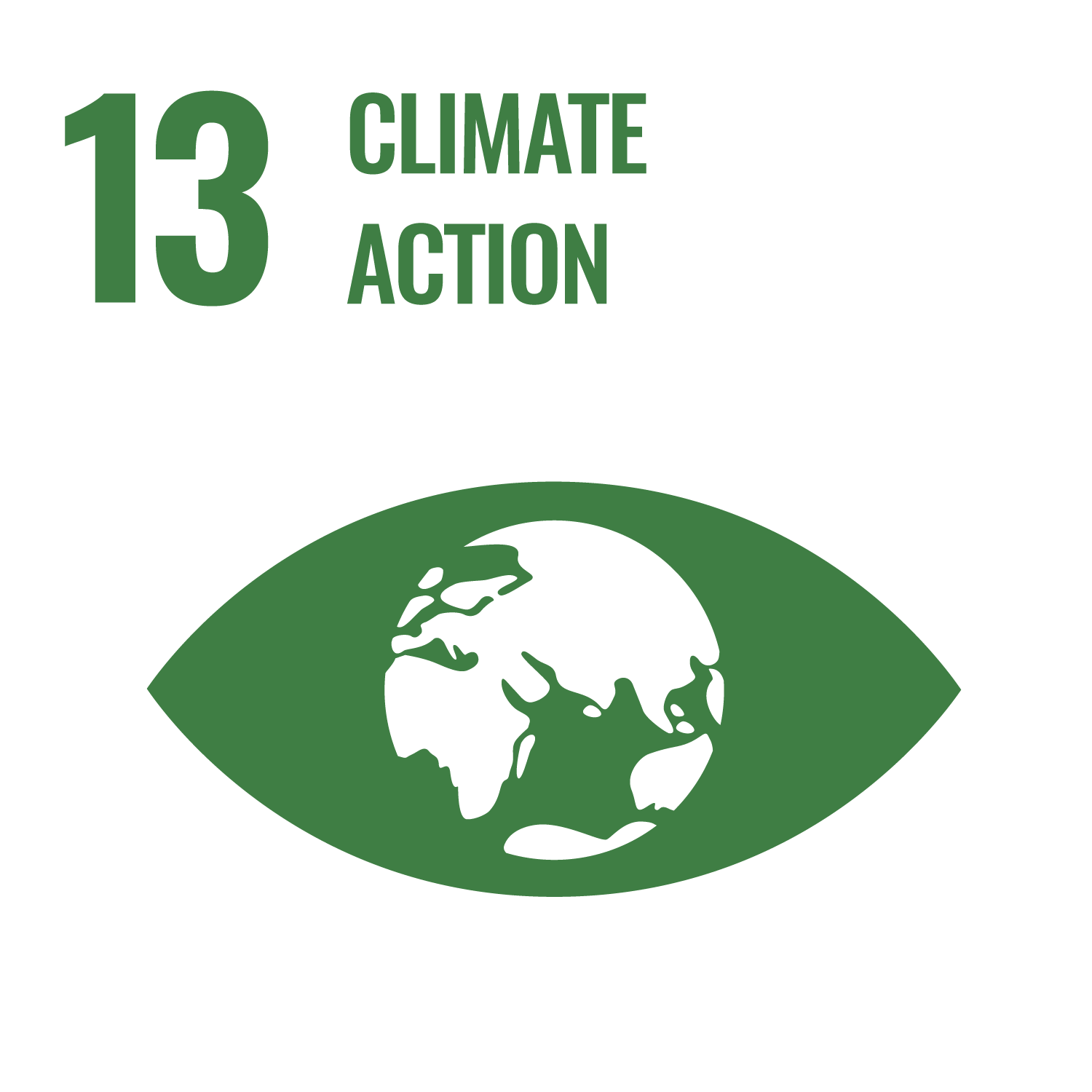 Goal 13. Climate Action
Goal 13. Climate Action
13.4.1 Commitment to carbon neutral university
Neutrality / Climate Action
Under SDG 13.4.1 – Institutional Commitment to Carbon Neutrality and Climate Action, AASTMT demonstrates strong engagement and leadership in integrating climate policies and sustainable practices across its academic and operational frameworks. The Academy’s approach aligns with Egypt’s National Climate Change Strategy 2050 and global frameworks such as the Paris Agreement and UN Sustainable Development Goals (SDGs).
2023-2024
AASTMT Carbon Emissions Reduction and Sustainability Progress Report (2024):
This report, presents AASTMT’s progress through 2024 towards reducing its carbon footprint and advancing sustainability goals. It tracks performance under Scopes 1, 2, and select Scope 3 emissions, benchmarked against prior baselines (2018–2021, 2022–2023), and aligns with the university’s Climate Action Plan targets—≥ 30% reduction by 2025 and 50% by 2040. The document outlines key drivers of change, including renewable energy expansion, energy efficiency upgrades, waste management, procurement practices, and climate education. In 2024, AASTMT achieved a −3.0% reduction in total emissions from 2023 and −32.8% relative to the 2019 baseline, demonstrating sustained decarbonization momentum and strategic alignment with broader climate action and sustainability objectives.
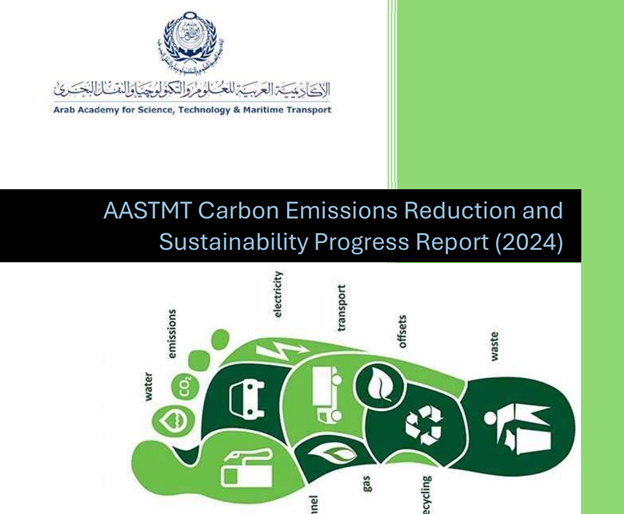
Renewable energy & energy-use tracking for all AAST campuses (2024 energy report):
In 2024, the Arab Academy for Science, Technology & Maritime Transport (AASTMT) continued its institutional commitment to climate action, carbon reduction, and energy sustainability through systematic monitoring of electricity consumption and renewable energy deployment across all campuses — including Alexandria, Al-Alamein, Sheraton, Smart (Dokki), Port Said, and Aswan.The report titled “AASTMT Insights: Energy Consumption and Carbon Emissions 2024” presents detailed data on solar photovoltaic (PV) installations, energy-use intensity, and greenhouse gas (GHG) emission trends. It supports the Academy’s transition toward low-carbon operations, targeting 25% renewable energy generation by 2025 and 40% by 2040.Energy tracking systems across campuses provide real-time insights for sustainable management, aligning with national energy-efficiency strategies and contributing directly to SDG 13 (Climate Action), SDG 7 (Affordable and Clean Energy), and SDG 11 (Sustainable Cities and Communities).
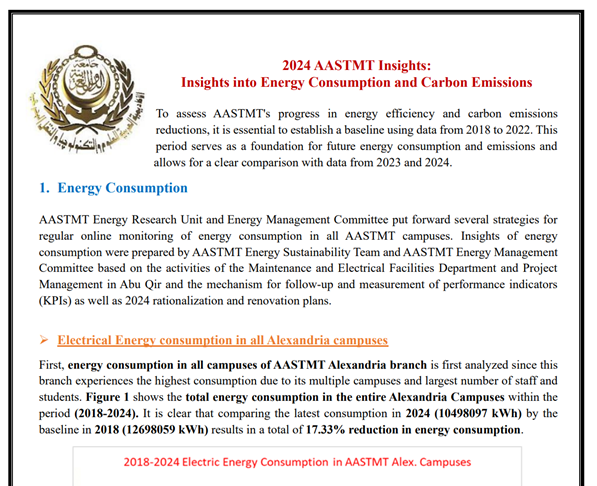
Net Zero Commitment:
The university’s Climate Action Plan (2023–2024) outlines measurable steps toward carbon neutrality, including a 25% renewable energy target by 2025 and 40% by 2040, supported by the integration of solar energy systems, energy efficiency measures, sustainable transport, and climate education.Through this commitment, AASTMT pledges to align with the Greenhouse Gas Protocols, maintain transparency via annual reporting, and contribute to global efforts to limit global warming to 1.5°C, reinforcing its role as a leader in climate action and sustainable transformation across all campuses.

AASTMT Environmental Sustainability Policy:
The Academy has a published environmental policy that explicitly includes “13.4 Commitment to carbon neutral university” among its SDG / climate-action commitments.

Recognition by QS World Sustainability Ranking 2024:
In December 2023, AASTMT was recognized in the QS Sustainability Rankings 2024 as the only non-governmental university in Egypt to be listed. This recognition indicates the institution’s commitment and visibility in sustainability among global peers.
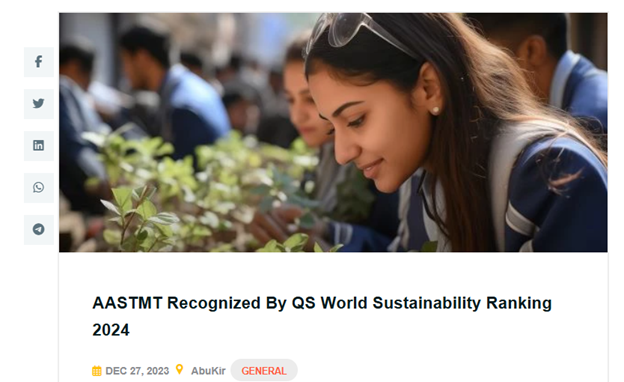
UI GreenMetric 2024 ranking:
AASTMT was ranked 453rd globally and 11th in Egypt in the 2024 UI GreenMetric rankings, which evaluates universities on environmental sustainability metrics (campus, energy, waste, etc.). This ranking demonstrates external validation of institutional commitment to environmental metrics.
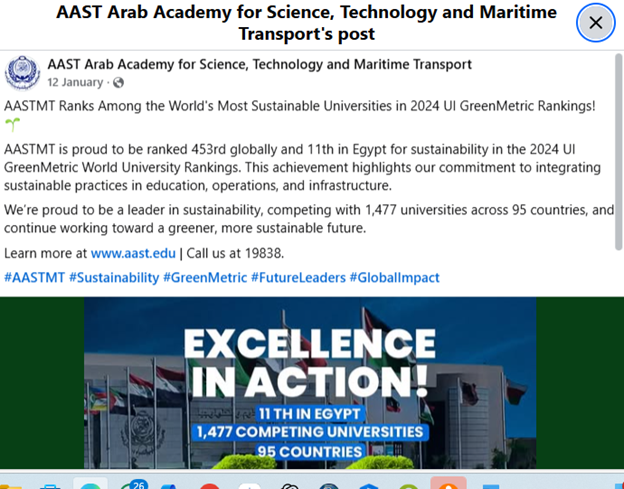
2025 IEEE 2nd Event at AASTMT, Alexandria (10–12 May 2025):
The institution is hosting a major IEEE event in 2025, which often includes tracks relevant to energy, sustainability, and environmental engineering.
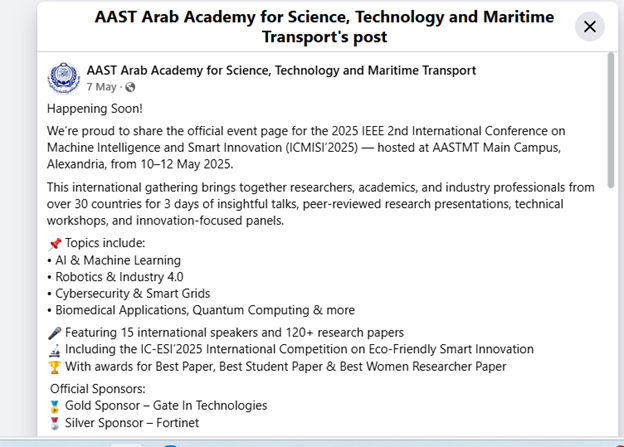
INTERREG (EU) Funding for Projects (2025):
AASTMT obtained funding for five innovative projects under the EU’s
INTERREG program, which often emphasize regional development, environmental
sustainability, and transboundary collaboration. While not explicitly labeled
climate, such projects often intersect with sustainable development agendas.
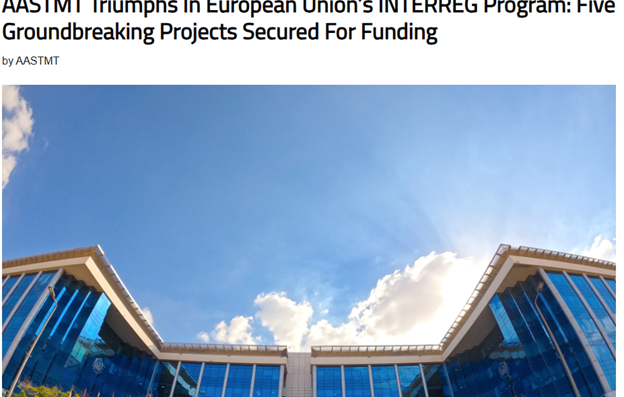
2022 - 2023
AASTMT is firmly committed to achieving carbon neutrality, addressing Scope 1, 2, and 3 emissions and reducing its carbon footprint in alignment with the Greenhouse Gas Protocols. Through comprehensive strategies, including renewable energy adoption, energy efficiency upgrades, and waste reduction initiatives, AASTMT aims to minimize CO2 emissions across its campuses. Guided by its Climate Action Plan and Green Energy Policy, the institution has set a clear target of achieving a 50% reduction in emissions by 2040 and full carbon neutrality by 2050. These efforts reflect AASTMT’s dedication to combating climate change, addressing global warming, and contributing to sustainable development goals through proactive climate action.
AASTMT’s 2022-2023 Carbon Emissions Report Outlines Path to Carbon Neutrality and Public Climate Action
The AASTMT 2022-2023 Carbon Emissions Report highlights the university’s unwavering commitment to achieving carbon neutrality by 2050, in line with the Greenhouse Gas Protocols. The report outlines comprehensive measures addressing Scope 1, 2, and 3 emissions, emphasizing energy efficiency, renewable energy adoption, and sustainable waste management. AASTMT’s proactive approach to CO2 reduction and its clear timeline for carbon neutrality underscore its dedication to combating climate change and promoting a low-carbon campus.

Explore AASTMT's 2022-2023 Carbon Neutrality Report.
AASTMT 2022-2023 Insights for Energy Consumption and Carbon Emissions
AASTMT’s 2022-2023 Insights for Energy Consumption and Carbon Emissions report highlights the institution's commitment to achieving carbon neutrality. By leveraging energy-efficient technologies and renewable energy solutions, AASTMT has reduced carbon emissions by 30% since 2019. The report outlines progress in addressing emissions across Scopes 1, 2, and 3, with clear targets of a 50% reduction by 2040 and carbon neutrality in line with Greenhouse Gas Protocols. These initiatives reinforce AASTMT’s role as a leader in sustainability and climate action.
AASTMT 2022-2023 Plan towards Clean Sustainable Energy
AASTMT's 2022-2023 Plan towards Clean Sustainable Energy demonstrates its commitment to achieving carbon neutrality. The plan sets ambitious targets, including a 30% CO2 reduction by 2025 and 50% by 2040, aligned with Greenhouse Gas Protocols. Key initiatives include energy-efficient upgrades, renewable energy expansion, and zero-waste strategies, showcasing AASTMT's leadership in sustainability and climate resilience.

Race to Zero Campaign
AASTMT’s participation in the global Race to Zero campaign underscores its commitment to becoming a carbon-neutral university. By aligning with Greenhouse Gas Protocols, AASTMT aims to achieve net-zero emissions, reinforcing its dedication to reducing CO2 emissions and supporting climate resilience through sustainable practices and operations.

AASTMT Launches MACI Journal to Advance Climate Education and Global Research Collaboration
The launch of AASTMT's MACI Journal demonstrates its commitment to achieving carbon neutrality by advancing global climate research and education. By providing a platform for peer-reviewed studies on CO2 emissions, climate adaptation, and sustainable development, the journal supports science-based strategies that align with the university’s goal of reducing its carbon footprint under the Greenhouse Gas Protocols.

AASTMT Collaborates with Alexandria Government on Coastal Protection and Climate Resilience for World Environment Day
AASTMT's collaboration with the Alexandria Government on coastal protection showcases its commitment to achieving carbon neutrality and addressing climate change impacts. This initiative focuses on research-driven strategies for mitigating coastal erosion and adapting to rising sea levels, aligning with AASTMT's goals under the Greenhouse Gas Protocols. These efforts reflect the university’s dedication to reducing CO2 emissions and advancing sustainable urban development.

AASTMT Students and Faculty Explore Sustainable Development and Climate Resilience at CEDARE
AASTMT's collaboration with CEDARE engages students and faculty in exploring sustainable development and climate resilience initiatives. This effort supports AASTMT’s commitment to achieving carbon neutrality by fostering research and knowledge sharing on climate change mitigation, greenhouse gas reduction, and sustainable practices. These activities align with AASTMT's goals under the Greenhouse Gas Protocols, advancing its mission to reduce CO2 emissions and build a low-carbon future.

AASTMT Hosts TuoMali International Conference to Address Marine Waste and Climate Resilience in the Mediterranean
AASTMT hosted the TuoMali International Conference to tackle marine waste and enhance climate resilience in the Mediterranean. This initiative highlights AASTMT’s commitment to reducing CO2 emissions through sustainable waste management strategies. The conference aligned with AASTMT’s goals under the Greenhouse Gas Protocols by addressing climate mitigation practices and advancing research for a carbon-neutral future.

The Arab Academy for Science, Technology & Maritime Transport (AASTMT) recognizes the critical importance of addressing climate change through actionable commitments. In line with this, AASTMT has dedicated efforts towards achieving carbon neutrality, a goal that aligns with Sustainable Development Goal 13 (SDG 13) and the Greenhouse Gas (GHG) Protocols. Indicator 13.4.1 focuses on the commitment of institutions to becoming carbon neutral, setting a target date for this achievement.
AASTMT’s approach towards carbon neutrality involves a comprehensive understanding of our current carbon footprint, followed by the implementation of strategies to reduce and offset these emissions. Our commitment is reflected in both our institutional policies and the practical steps we are taking on our campuses.
Implementation of Carbon Neutrality Commitment:
- A critical step in our journey towards carbon neutrality has been the assessment of our campus carbon footprint for the period 2018-2021. This comprehensive analysis provides a detailed understanding of our emissions across various campus operations.
- The carbon footprint report includes emissions from sources such as energy consumption in buildings, transportation used for academic purposes, and other campus activities. By quantifying our greenhouse gas emissions, AASTMT can identify key areas where emissions can be reduced and implement targeted sustainability initiatives.
- Following the assessment, AASTMT has developed and begun implementing a series of measures to reduce its carbon footprint. These include energy efficiency improvements, increasing the use of renewable energy sources, waste reduction strategies, and enhancing sustainable transportation options.
- The Campus Carbon Footprint report is a pivotal document that guides our strategies and actions towards reducing our environmental impact. It serves as a baseline against which future reductions can be measured and is integral to our planning for carbon neutrality.
AASTMT's commitment to achieving carbon neutrality is an ongoing process that involves continuous evaluation and adaptation of our strategies. By setting a target date for carbon neutrality and taking concrete steps towards this goal, AASTMT is not only contributing to global climate action efforts but also setting a standard for environmental stewardship in the region. Through these initiatives, AASTMT aspires to be a model for sustainable practices in higher education and beyond.
Campus Carbon Footprint 2018-2021 on the AASTMT web page



